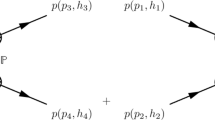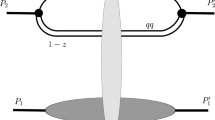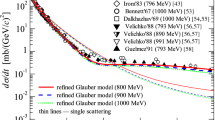Abstract
The scattering amplitude with spin-non-fiip and spin-flip components represented by Froissaron, Maximal Odderon as well as by standard Regge poles contributions is considered. From the fit to the data of pp and \(\bar{p}p\) scattering at high energy and not too large momentum transfers we found that this model taking into account the spin is available to describe not only the differential, total cross section and \(\rho \), but also the existing experimental data on polarization. It allows to make some predictions about spin effects at high energies.







Similar content being viewed by others
Data Availability Statement
This manuscript has no associated data or the data will not be deposited. [Author’s comment: The datasets generated and used during the study are available in the HEPdata repository, https://www.hepdata.net. These datasets are available as well from the corresponding author on reasonable request.]
References
N.H. Buttimore et al. The spin dependence of high-energy proton scattering. Phys. Rev. D59, 114010 (1999). arxiv:hep-ph/9901339v1
E. Leader, Spin in Particle Physics (Cambridge University Press, Cambridge, 2001), p. 500
C. Ewerz, P. Lebiedowicz, O. Nachtmann, A. Szczurek, Phys. Lett. B 763, 382 (2016). arxiv:1606.08067v1
S. Donnachie, G. Dosch, P. Landshoff, O. Nachtmann, Pomeron Physics and QCD (Cambridge University Press, Cambridge, 2002)
S.M. Troshin, N.E. Tyurin, Spin Phenomena in Particle Interactions (World Scientific Publishing Company, Singapore, 1994), p. 224
A.F. Martini, E. Predazzi, Diffractive effects in spin flip pp amplitudes and predictions for relativistic energies. Phys. Rev. D 66, 034029 (2002). arXiv:0209.027v1
K. Hinotani, H.A. Neal, E. Predazzi, G. Walters, Behavior of the spin-flip amplitude in high-energy proton-proton and pion-proton elastic scatterings. Nuovo Cimento 52A, 363 (1979)
G. Fidecaro et al., Measurement of the polarization parameter in pp elastic scattering at \(p_{lab}\)=150 GeV/c. Nucl. Phys. B173, 513 (1980)
G. Fidecaro et al., Measurement of the differential cross section and of the polarization parameter in \(pp\) elastic scattering at \(p_{lab}\)=200 GeV/c. Phys. Lett. 105B, 309 (1981)
R.V. Kline et al., Polarization parameters and angular distributions in pi-p elastic scattering at 100 GeV/c and in \(pp\) elastic scattering at \(p_{lab}\)100 GeV/c and 300 GeV/c. Phys. Rev. D 22, 553 (1980)
L. Adamczyk et al., STAR Collaboration, Single spin asymmetry \(A_N\) in polarized proton–proton elastic scattering at \(\sqrt{s}\)= 200 GeV, Phys. Lett. B 719, 62–69 (2013). arxiv:1206.1928v3
K.G. Boreskov, A.M. Lapidus, S.T. Sukhorukov, K.A. Ter-Martirosyan, Elastic scattering and charge exchange reactions at high energy in the theory of complex angular momentum. Sov. J. Nucl. Phys. 14, 814 (1971)
J.-R. Cudell, E. Predazzi and O.V. Selyugin. High-energy hadron spin-flip amplitude at small momentum transfer and new \(A_{\nu }\) data from RHIC. EPJ A 10012-2 (2004). arxiv:hep-ph/0401040v1
O.V. Selyugin, J.R. Cudell, Odderon, HEGS model and LHC data. Acta Phys. Polon. Supp. 12, 4 (2019). arxiv:1512.05130v1
O. V. Selyugin, High energy hadron spin flip amplitude. Phys. Part. Nucl. Lett. 13 3, 303 (2016). arxiv:1512.05130v1
B.Z. Kopeliovich, M. Krelina, I.K. Potashnikova, Probing the Pomeron spin structure with Coulomb-nuclear interference. Phys. Lett. B 816, 136262 (2021). arxiv:1910.04799v3
O.V. Selyugin, Nucleon structure and spin effects in elastic hadron scattering. Symmetry 13, 164 (2021). arXiv:2012.08891v3 [hep-ph]
M.V. Galynskii, E.A. Kuraev, Alternative way to understand the unexpected result of JLab polarization. Phys. Rev. D 89, 054005 (2014). arxiv:1312.3742v3
TOTEM Collaboration, G. Antchev et al. Proton-proton elastic scattering at the LHC energy of \(\sqrt{s}\)=7 TeV. EPL 95 41001 (2011). arxiv:1110.1385v1
TOTEM Collaboration, G. Antchev et al. First measurement of the total proton-proton cross-section at the LHC energy of \(\sqrt{s}\)= 7 TeV. EPL 96, 21002 (2011). arxiv:1110.1395v1
TOTEM Collaboration, G. Antchev et al. Measurement of proton-proton elastic scattering and total cross-section at \(\sqrt{s}\) = 7 TeV. EPL 101, 21002 (2013) (CERN-PH-EP-2012-352.pdf)
TOTEM Collaboration, G. Antchev et al. Luminosity-independent measurements of total, elastic and inelastic cross-section at \(\sqrt{s}\)= 7 TeV, EPL 101, 21004 (2013) (CERN-PH-EP-2012-353.pdf)
TOTEM Collaboration, G. Antchev et al. Luminosity- independent measurements of proton-proton total cross section at \(\sqrt{s}\) = 8 TeV. Phys. Rev. Lett. 111, 012001 (2013) (CERN-PH-EP-2012-354)
TOTEM Collaboration, G. Antchev et al. Evidence for Non-Exponential elastic proton-proton differential cross section at low \(|t|\) and \(\sqrt{s}\)=8 TeV. Nucl. Phys. B899, 527 (2015). arxiv:1503.08111v4
TOTEM Collaboration, G. Antchev et al. Measurement of elastic pp scattering at \(\sqrt{s}\) = 8 TeV in the Coulomb – Nuclear interference region – determination of the \(\rho \) parameter and the total cross section. Eur. Phys. J. C76, 661 (2016). arxiv:1610.00603v1
TOTEM Collaboration, G. Antchev et al. First measurement of elastic, inelastic and total cross section at \(\sqrt{s}\)=13 TeV by TOTEM and overview of cross section data at LHC energies. Eur. Phys. J. C 79, 103 (2019). arxiv:1712.06153v2
TOTEM Collaboration, G. Antchev et al. First determination of the \(\rho \) parameter at \(\sqrt{s}\)=13 TeV: Probing the existence of a colourless C-odd three-gluon compound state. Eur. Phys. J. C 79, 785 (2019). arxiv:1812.04732v1
TOTEM Collaboration, G. Antchev et al. Elastic differential cross-section measurement at \(\sqrt{s}\)=13 TeV by TOTEM. Eur. Phys. J. C 79, 861 (2019). arxiv:1812.08283v1
TOTEM Collaboration, G. Antchev et al. Elastic differential cross-section at \(\sqrt{s}\) = 2.76 TeV and implications on the existence of a colorless 3-gluon bound state. Eur. Phys. J. C80, 91 (2020). arxiv:1812.08610v1
Y. Hagiwara, Y. Hatta, R. Pasechnik, J. Zhou, Spin-dependent Pomeron and Odderon in elastic proton-proton scattering. EPJC 80, 427 (2020). arxiv:2003.03680
P. Lebiedowicz, O. Nachtmann, A. Szczurek, Central exclusive diffractive production of \(K^+ K^- K^+ K^-\) via intermediate \(\phi \phi \) state in proton-proton collisions. Phys. Rev. D 99, 094034 (2019)
P. Lebiedowicz, O. Nachtmann, A. Szczurek, Searching for the odderon in \(p p \rightarrow p p K^+ K^-\) and \(pp \rightarrow p p \mu ^+ \mu ^-\) reaction in the \(\phi (1020)\) resonance region at the LHC. Phys. Rev. D 101, 094012 (2020)
R.A. Janik, J. Wosiek, Phys. Rev. Lett. 82, 1092 (1999)
J. Bartels, L.N. Lipatov, G.P. Vacca, Phys. Lett. B 447, 178 (2000)
L. Łukaszuk, B. Nicolescu, Lett. Nuovo Cim. 8, 405 (1973)
E. Martynov, B. Nicolescu. Did TOTEM experiment discover the Odderon Phys. Lett. B778, 414 (2018). arxiv:1711.03288v6
E. Martynov, B. Nicolescu. Evidence for maximality of strong interactions from LHC forward data. B786, 207 (2018). arxiv:1804.10139v3
E. Martynov, B. Nicolescu. Odderon effects in the differential cross-sections at Tevatron and LHC energies. EPJ C 79, 461 (2019). arxiv:1808.08580v3
T. Csörgő, T. Novák, R. Pasechnik, et al., Evidence of Odderon-exchange from scaling properties of elastic scattering at TeV energies. Eur. Phys. J. C 81, 180 (2021). arXiv:1912.11968v3
V.M. Abazov et al., Comparison of \(pp\) and \(\bar{p}p\) differential elastic cross sections and observation of the exchange of a colorless C-odd gluonic compound, FERMILAB-PUB-20-568-E, CERN-EP-2020-236. arxiv:2012.03981v1
T. Csörgő, I. Szanyi, Observation of Odderon Effects at LHC energies—a real extended Bialas-Bzdak model study. Eur. Phys. J. C 81, 611 (2021). arxiv:2005.14319v3
G. Auberson, T. Kinoshita, A. Martin, Phys. Rev. D 3, 3185 (1971)
https://pdg.lbl.gov/2017 ; C. Patrignani et al. (Particle Data Group), Chin. Phys. C 40, 100001 (2016) and 2017 update. https://pdg.lbl.gov/2017/hadronic-xsections/hadron.html
https://www.hepdata.net (the old version of the Data Base is available at http://hepdata.cedar.ac.uk)
Acknowledgements
We thank Prof. B. Nicolescu and Prof. S.M. Troshin for a careful reading the manuscript, comments and useful discussions. E.M. and G.T. were partially supported by the Project of the National Academy of Sciences of Ukraine (0118U003197).
Author information
Authors and Affiliations
Corresponding author
Additional information
Communicated by Reinhard Alkofer
Appendices
Appendix A: Simplified FMO model
The simple and dipole Pomerons (Odderons) for both components have a conventional form:
where \({\tilde{s}}=-i(s-2m^2)/2m^2\), \(\xi =\ln ({\tilde{s}})\).
It is important that we use for single and double j-poles the pomeron and odderon intercepts equal to one
avoiding a violation of unitary restriction for total cross sections.
where m is proton mass. A choice of \(\lambda _{\pm }(t)\) is discussed in the Sect. 3.1 .
The tripole terms \(P^{(T)}, O^{(T)}\), containing only asymptotic main components from the Froissaron and Maximal Odderon [38]), which are defined in according with the AKM asymptotic theorem [42]
where \(z_p=r_p\tau \xi , \quad z_o=r_o\tau \xi , \quad \tau =\sqrt{-t/t_0}, \quad t_0=1\, \text {GeV}^2, \quad r_p, r_o\) are constants.
Contributions of the secondary reggeons, f and \(\omega \) have a standard form
Appendix B: Original FMO model
We write here the explicit spin-non-flip terms of the FMO model at \(t\le 0\) [38] just for reader’s convenience. The only difference of [38] is a notation for constants and functions. Spin-flip terms are presented and discussed in Sect. 3.2.
Froissaron and Maximal Odderon are written in the following form
where \(z=2m^2z_t, \quad \xi =\ln (-iz_t), \quad \tau =\sqrt{-t/t_0}, \quad t_0=1\,\,\text {GeV}^2\), \(r_- =r_+ -\delta r_-,\quad \delta r_-\ge 0\).
The effective secondary Regge pole contributions (crossing-even f and crossing-odd \(\omega \)) have the form
In order to perform calculations of the standard pomeron and odderon cuts in explicit analytical form we have made replacement \(z_t\rightarrow z_0=z_t(t=0)\)
This parametrization takes into account a possibility of a non pure exponential behavior of the vertex functions for the standard pomeron and odderon [38].
The factor \(2m^2\) is inserted in amplitudes \(f,\omega , P,O\) in order to have the normalization for amplitudes and dimension of coupling constants (in milliibarns ) coinciding with those in [36].
We have added in the FMO the double pomeron and odderon cuts, PP, OO, PO in their usual standard form without any new parameters as well. Namely,
where \(B_k^{p,o}=b_{1,k}^{P.O}+\alpha '_{P,0}\ln (-iz_0),\quad k=1,2 , \quad b_{1,k}^{P,O}\) are the constants from single pomeron and odderon contributions.
In [38] it was noted that for a better description of the data it is advisable to add to the amplitudes the contributions that mimic some properties of ”hard“ pomeron (\(P^h\)) and odderon (\(O^h\)). We take them in the simplest form
Rights and permissions
About this article
Cite this article
Bence, N., Lengyel, A., Tarics, Z. et al. Froissaron and Maximal Odderon with spin-flip in pp and \(\bar{p}p\) high energy elastic scattering. Eur. Phys. J. A 57, 265 (2021). https://doi.org/10.1140/epja/s10050-021-00563-z
Received:
Accepted:
Published:
DOI: https://doi.org/10.1140/epja/s10050-021-00563-z




